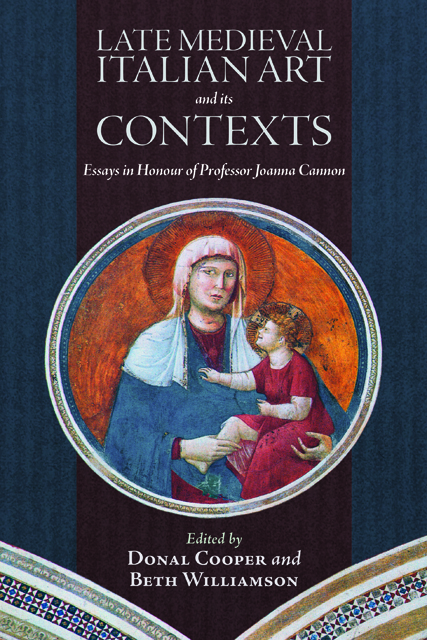Book contents
- Frontmatter
- Contents
- List of Illustrations
- List of Contributors
- Acknowledgements
- List of Abbreviations
- 1 Introduction: Circling Giotto
- 2 Holy Wood / ‘sacra tavola’: Saint Dominic and the Memory of Miracles in Bologna
- 3 The Sculpted Saint: A Statue of Saint Francis in Siena
- 4 Guccio di Mannaia and the Concept of a ‘Franciscan’ Chalice
- 5 ‘Speculum sine macula’: The Trittico di Santa Chiara in Trieste as an Object of Clarissan Devotion
- 6 The Siena Connection: A Franciscan Provincial Minister between Tuscany and Assisi at the Dawn of the Trecento
- 7 Simone Martini’s ‘Treaty with the House of Santa Fiora’ in Siena’s Palazzo Pubblico: Its Date and Significance
- 8 Crisis and Charity in Fourteenth-Century Florence: Ambrogio Lorenzetti’s Saint Nicholas Panels for San Procolo
- 9 Father of Light: Giotto and the Beatific Vision in the Baroncelli Chapel
- 10 Painter-Illuminator Workshops and the Church of San Giorgio a Ruballa: The Case of Bernardo Daddi and Pacino di Bonaguida
- 11 Patterns of Holiness: A Virgin Lactans in a Franciscan Context
- 12 A New Angle on Simone Martini’s Holy Family
- 13 Artistic Appropriation, Institutional Identity, and Civic Religion in Fourteenth-Century Siena: The Byzantine Treasury of the Hospital of Santa Maria della Scala
- 14 Visual Religious Education in Late Medieval Florence: Zanobi Perini, The Leggenda di Santo Tobia, and The Misericordia
- 15 Saints and Status in Late Medieval and Early Renaissance Florence
- Select Bibliography
- Publications by Joanna Cannon
- Index
- Tabula Gratulatoria
- Backmatter
10 - Painter-Illuminator Workshops and the Church of San Giorgio a Ruballa: The Case of Bernardo Daddi and Pacino di Bonaguida
Published online by Cambridge University Press: 20 December 2022
- Frontmatter
- Contents
- List of Illustrations
- List of Contributors
- Acknowledgements
- List of Abbreviations
- 1 Introduction: Circling Giotto
- 2 Holy Wood / ‘sacra tavola’: Saint Dominic and the Memory of Miracles in Bologna
- 3 The Sculpted Saint: A Statue of Saint Francis in Siena
- 4 Guccio di Mannaia and the Concept of a ‘Franciscan’ Chalice
- 5 ‘Speculum sine macula’: The Trittico di Santa Chiara in Trieste as an Object of Clarissan Devotion
- 6 The Siena Connection: A Franciscan Provincial Minister between Tuscany and Assisi at the Dawn of the Trecento
- 7 Simone Martini’s ‘Treaty with the House of Santa Fiora’ in Siena’s Palazzo Pubblico: Its Date and Significance
- 8 Crisis and Charity in Fourteenth-Century Florence: Ambrogio Lorenzetti’s Saint Nicholas Panels for San Procolo
- 9 Father of Light: Giotto and the Beatific Vision in the Baroncelli Chapel
- 10 Painter-Illuminator Workshops and the Church of San Giorgio a Ruballa: The Case of Bernardo Daddi and Pacino di Bonaguida
- 11 Patterns of Holiness: A Virgin Lactans in a Franciscan Context
- 12 A New Angle on Simone Martini’s Holy Family
- 13 Artistic Appropriation, Institutional Identity, and Civic Religion in Fourteenth-Century Siena: The Byzantine Treasury of the Hospital of Santa Maria della Scala
- 14 Visual Religious Education in Late Medieval Florence: Zanobi Perini, The Leggenda di Santo Tobia, and The Misericordia
- 15 Saints and Status in Late Medieval and Early Renaissance Florence
- Select Bibliography
- Publications by Joanna Cannon
- Index
- Tabula Gratulatoria
- Backmatter
Summary
The space around medieval church altars at times involved various audiences – from both clerics and members of the laity – who observed or handled objects in a range of media in the performance of the liturgy. This theme of access to works of art and the relationship between media and use has been a strong undercurrent in the scholarly and pedagogical work of Joanna Cannon, with whom I shared a memorable, indeed careeraltering, conversation about Bernardo Daddi and painters of illuminated manuscripts. That discussion was the catalyst for a journey – of a long bus ride and dizzying hike – to a remote parish church in the hills of Tuscany that is associated with an impressive array of fourteenth-century objects, some of which are still there and some of which can be traced back to it. These objects are the subject of this essay.
The polyptych with The Crucifixion and Saints, presently in The Courtauld Gallery (Plate XIII), was arguably the last great commission undertaken by Bernardo Daddi and his workshop. Beneath the central panel is an inscription indicating the artist’s name and the date 1348, providing a chronological point of reference for the commission and indicating a terminus point for Daddi’s career, as he died on 8 August of that year, likely as a result of causes related to the Black Death. The painting once adorned an altar within the intimate space of the parish church of San Giorgio a Ruballa (Osteria Nuova di Bagno a Ripoli), founded by at least 1273 and renovated around 1337. The glimmer of the Trecento interior is almost completely lost, now overshadowed by the Baroque stucco work of Giovan Martino Portogalli (1707) and the architectural redesign by Niccolo Matas (1863). Yet three early Trecento works are still housed within. The first is a large devotional panel with the Maesta: The Virgin and Child with Angels and Saints Matthias the Apostle and George, dated with a partially abraided inscription to 1336 or 1337 and thought to be the work variously of Maso di Banco, Orcagna, Bernardo Daddi or an artist in his shop, or an anonymous painter conventionally referred to as the Maestro di San Giorgio a Ruballa (Fig. 10.1). Next is a choir book assigned to the workshop of Pacino di Bonaguida and stylistically dated to the 1330s – (Plate XIV).
- Type
- Chapter
- Information
- Late Medieval Italian Art and its ContextsEssays in Honour of Professor Joanna Cannon, pp. 181 - 202Publisher: Boydell & BrewerPrint publication year: 2022



